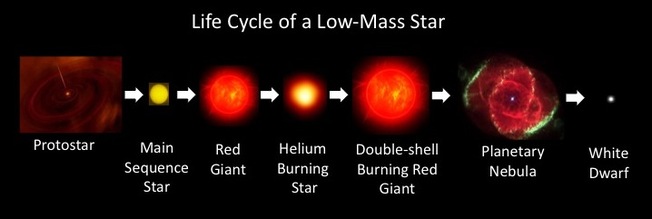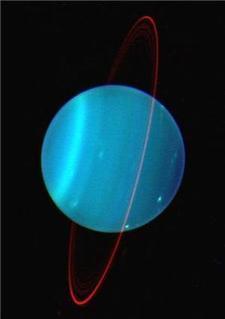
For my third blog, I was instructed to talk about anythingl to do with stars. I, being in a Physics 1040 class, learned many things about stars. The thing that grabbed my attention the most was the life cycles of stars. Particularly the life cycle of low mass stars, like our sun. I decided i needed to know a little bit more about my subject, so between my book, my own regoglection, and with a little help from Nasa's website, this is what i have came up with.
A low mass star changes throughout it's life cycle. Stars begin to form from clouds of gas in space. The cold temperatures and high densitiesof these clouds allow gravity to overcome thermal pressure and start the gravitational collapse that will form a star. As the cloud collapses, is begins to spin and by the time a protostar is formed, the cloud flattens and there is a protostellar disk spinning around the protostar. It then forms into a protostar. A protostar is a star that is still forming. It looks like a star but its core is not yet hot enough for fusion to take place. A protostar becomes a main sequence star when its core temperature exceeds 10 million K. This is the temperature needed for hydrogen fusion to operate efficiently.The length of time all of this takes depends on the mass of the star. The more massive the star, the faster everything happens. Collapse into a star like our Sun takes about 50 million years. The collapse of a very high mass protostar might take only a million years. Smaller stars can take more than a hundred million years to form.
Once the protostar becomes a main sequence star they spend billions of years fusing hydrogen to helium in their cores using the proton-proton chain. Over its lifetime, a low mass star consumes its core hydrogen and converts it into helium. The core shrinks and heats up gradually and the star gradually becomes more luminous. Eventually nuclear fusion exhausts all the hydrogen in the star's core.The star has now reached the red-giant phase.
It is red because it is cooler than it was in the main sequence star stage and it is a giant because the outer shell has expanded outward. When hydrogen fusion can no longer happen in the core, gravity begins to collapse the core again. The star's outer layers expand while the core is shrinking and as the expansion continues, the luminosity begins to increase. A hydrogen burning shell forms around the helium core, and she shell contributes more and more helium to the core over time. Eventually the core becomes hotter and denser and helium nuclei begin to fuse into carbon. The helium fusion then heats the core rapidly even more This causes the core to expand, which lowers the temperature of the core and reduces the total energy output from what it was during the red giant phase. After about 100 million years, the star fuses all its core helium into carbon. Then a helium fusion shell forms around this core, and the hydrogen fusion shell remains around that. It then becomes a red giant again and remains like this for a few million years with its outer layers continuing to expand. Eventually gravity can no longer contain the outer layers of the red giant and the star ejects these layers into space. The remaining carbon core is still very hot and radiation that ionizes the gas in the expanding shell and makes it glow brightly. Thus starts the final phases of the stars life, the planetary nebula and then the white dwarf phase.
As the core cools, the glowing gas fades and disperses and the planetary nebula dissapears. The cooling carbon core is all that is left. The cooling core is called a White Dwarf. The matter in white dwarfs is very dense. A teaspoon of it, if brought to earth, would weigh several tons.

In my astronomy class, we have just recently leanerd about the planets, and how there are the two kinds. There are the Jovian planets and the Terrestrial planets. I got really interested in learning about them, so when i had to write a blog about them, i got excited! In my search to find out more about the planets I was to do my blog on, I found this very interesting article and decided that I had to write about it.
Uranus is part of the Jovian planets, it is the seventh planet from the sun. There is one thing very different about Uranus, its tilt. It has a tilt of 97.77 degrees, and because of this it is kind of the odd ball out in the solar system. The present theory that we have all grown to know and love is that Uranus was knocked on its side by a single large impact, but now there is a new theory that states early in its life Uranus experienced a succession of small punches instead of a single knock-out blow.
Uranus is unusual in that its spin axis is inclined by 98 degrees compared to its orbital plane around the Sun. This is far greater than other planets, such as Jupiter (3 degrees), Earth (23 degrees), or Saturn and Neptune (29 degrees). Uranus is, in effect, spinning on its side.The generally accepted theory is that in the past a body a few times more massive than Earth collided with Uranus, knocking the planet on its side. There is, however, one significant flaw in this notion: the moons of Uranus should have been left orbiting in their original angles, but they too lie at almost exactly 98 degrees.
This long-standing mystery has been solved by an international team of scientists led by Alessandro Morbidelli. Morbidelli and his team used simulations to reproduce various impact scenarios in order to discover the most likely cause of Uranus' tilt. They discovered that if Uranus had been hit when still surrounded by a protoplanetary disk, the material from which the moons would form, then the disk would have reformed into a fat doughnut shape around the new, highly-tilted equatorial plane. The collisions within the disk would have flattened the doughnut, which would then go onto form the moons in the positions we see today. However, the simulation threw up an unexpected result. in the first scenario, the moons displayed retrograde motion, (which i can explain to you because i have learned it in class) it means they orbited in the opposite direction to that which we observe. Morbidelli's group tweaked their parameters in order to explain this. The surprising discovery was that if Uranus was not tilted by one hit, as it is commonly thought to be, but rather was bumped by at least two smaller collisions then there is a much higher probability of seeing the moons orbit in the direction we observe.